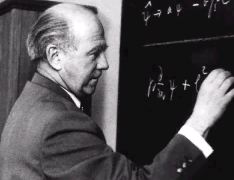
Let me sum up what I've said so far. The microscopic world has a property called "wave計article duality." (So does the macroscopic world, but the effects of wave計article duality aren't noticeable for large objects.) What this means is that every particle, such as a photon, electron, proton, positron, and so on, has a wave associated with it. The amplitude (size) of this wave describes the probability of finding the particle in that region. In any observation of the particle, it will probably be found where the amplitude is large, and will probably not be found where the amplitude is small, but there's an uncertainty in the position of the particle.
The wave will generally not be spread throughout the entire universe, but will be confined to a small region in space. This "localized" wave is called a wave packet. A wave packet does not have one specific wavelength, but is made up of waves of a variety of wavelengths. And the momentum of a wave計article depends on its wavelength. So a wave計article that isn't spread out over the entire universe doesn't have a specific momentum; it has many momenta. In other words, there's an uncertainty in the momentum of the particle. (We're getting close, can you tell?)
Now suppose the wave is pretty much confined to a region in space with a width we'll call delta-x. (For you statheads out there, this is the standard deviation of the square of the wave function. The "wave function" is just the mathematical expression that describes the wave.) And suppose the momenta that make up the wave fall within a range given by delta-p (again, a standard deviation of the momentum distribution). These two numbers represent the uncertainty in the position of the particle and the uncertainty in the momentum of the particle.
Which brings us to the uncertainty principle. What Heisenberg discovered is that a wave packet confined to a very small region must be made up of a lot of different wavelengths, and therefore a lot of different momenta. In other words, if the uncertainty in the position of the particle is small, the uncertainty in the momentum is large. And similarly, a particle whose wave packet is made up of only a few wavelengths (and hence only a few momenta) will be spread out over a large region. That is, if the uncertainty in momentum is small, the uncertainty in position is large.
Mathematically, Heisenberg's result looks like this:
![]()
This means just what I said in the preceding paragraph. The smaller delta-x is, the larger delta-p has to be (and vice versa) so that the product is larger than h-bar/2. H-bar (the h with a slash through it) incidentally, is called Planck's constant. It first turned up in Planck's paper on blackbody radiation.
Now the uncertainty principle is not something we notice in everyday life. For example, we can weigh an automobile (to find its mass), and all automobiles have speedometers, so we can calculate the momentum. But doing so will not make the position of the car suddenly become hazy (especially if we're inside it). So measuring the momentum of the car seems to produce no uncertainty in the car's position.
The reason we don't notice the uncertainty principle in everyday life is because of the size of Planck's constant. It's very small:
![]()
If you don't know what a Joule新econd is, don't worry about it. The point is that Planck's constant is a very small number! So let's take an example. The mass of a baseball is about .145 kg. Let's suppose a radar gun can measure its speed to within .1 mph. (I'm told by one reader that it's actually more like .25 mph, but I've already worked it out for .1. Either way the result is about the same.) This .1 mph (which is about .045 meters/second) is the uncertainty in the velocity of the ball. Since momentum is mass times velocity, this means the uncertainty in the the momentum of the ball is .145 x .045 = .0065 kg搶/s.
Then the Heisenberg uncertainty principle tells us that the uncertainty in position has to be at least as large as:
![]()
which comes out to 8 x 10-30 (that is, .000000000000000000000000000008) millimeters. Well, you can't measure that, especially for a moving baseball, so you never notice the uncertainty in position. You get a similar result when you apply the uncertainty principle to any object large enough to see. The uncertainty is just too small to be noticed. While the uncertainty principle applies to anything, it's only noticeable for very microscopic particles. In the physics of subatomic particles, it's an often crucial fact that we can't know both the position and the momentum of a particle. That's the Heisenberg uncertainty principle.